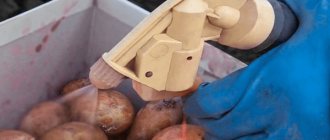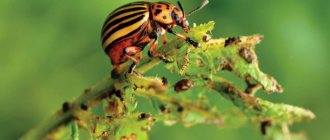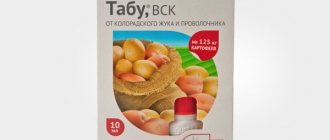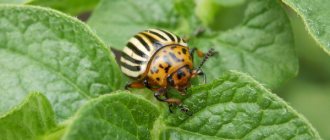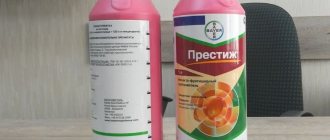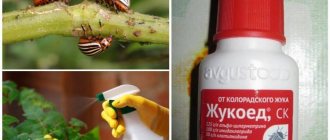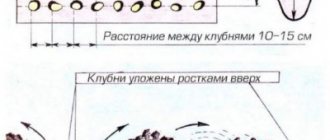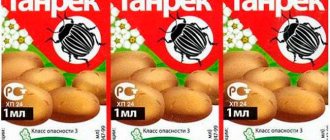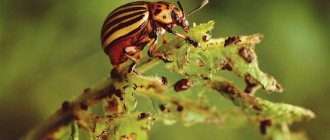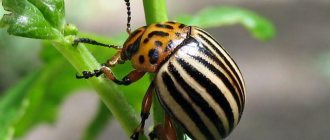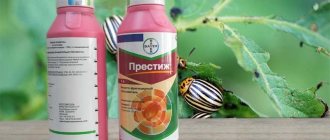Traditionally, we begin pest control when we already see the results of their activity on our cultivated plants. Why not think about prevention? It’s even better to remember in the spring that there are soil pests against which spraying the tops is not very effective. Until the potatoes are in the ground, we have a chance to protect them from wireworms, mole crickets, and even from the dangerous leaf beetle - the Colorado potato beetle. There are a lot of modern means and methods for treating tubers before planting.
- 2 How to treat potatoes before planting against wireworms
2.1 Table: chemicals
- 2.2 Video: other drugs and the need for re-treatment
- 3.1 Video: area inhabited by mole crickets; mechanical pest control
- 4.1 Video: the effect of using the insecticide Prestigitator without re-treatment during the growing season
- 5.1 Photo gallery: preparations for treating seed potatoes and holes
Pre-sowing treatment - a barrier to pests
In the spring, when the soil thaws, the pests that hibernate in it wake up. They are actively looking for a power source. Insects living in the soil are content with the hard roots of perennial grasses - nettle, burdock, dandelion, wheatgrass. After all, there are no more delicious young plants yet. But with the arrival of gardeners to the plots, the real feast begins. We ourselves bring food to the pests: we sow root crops, plant seedlings. But potatoes are the first to come under attack, since at the time of planting the plants have not yet grown from the seeds, and it is too early to plant seedlings.
The wireworm makes its way to the feeding site
As soon as the tubers are in the ground, soil pests move on to them. They feed on juicy sprouts and sweet young roots, and bite into the inside of potatoes. Fortunately, every seed potato has several sprouts. Out of 5-6, 2-3 will remain undamaged, they will germinate and give us a harvest. Meanwhile, the insects remain in the field and continue to feed on stolons and young nodules. The bush loses strength and does not produce the expected harvest. We would get a lot more if we didn't share with pests. Pre-sowing preparation makes potatoes unattractive, tasteless and even poisonous for wireworms, mole crickets and Colorado potato beetles that have become hungry over the winter.
Fighting with folk remedies
As you can see, there are plenty of chemicals against the Colorado potato beetle, but as a result of their treatment of nightshade crops, the poisons sooner or later end up in our stomach. How to deal with the Colorado potato beetle without endangering your health? Mechanical collection of beetles is an effective and safe method, but it is unrealistic for owners of large plantings to deal with pests using this method. In such cases, they resort to less radical, but non-toxic to humans, treatment of areas with folk remedies. We offer you recipes for several of the most effective compositions against leaf beetles:
- Pour 1 kg of fresh leaves and green walnut fruits into 10 liters of boiling water, leave for a week under the lid, then strain;
- Pour 300 g of dried leaves and walnut shells into 10 liters of boiling water, leave covered for a week and strain;
- Infuse 1 kg of dry crushed white acacia bark in 10 liters of water for three days, then strain;
- pour half a bucket of poplar leaves with water, boil for 15 minutes, bring the volume to 10 liters, leave for 3 days and drain;
- Dilute 100 g of birch tar in a bucket of water and carry out three treatments of nightshades with this solution within a week;
- leave half a kilogram of sunflower flowers in a bucket of water for three days, strain;
- Pour 1.5 kg of celandine with hot water and leave covered for 3 hours, then strain and pour in a one and a half percent solution of calcium chloride;
- Pour a full bucket of crushed fresh or dry celandine with hot water and boil over low heat for 15 minutes. Drain the resulting broth and use it to prepare an aqueous solution in a ratio of 1:20 (or half a liter of infusion per 10 liters of water);
- Pour boiling water over 100 g of crushed dry elecampane roots and leave for two hours. The plants are treated with this product for the first time when they reach a height of 15 cm. In total, it is advisable to carry out 3 treatments with an interval of 10 days;
- Pour 300 g of onion peel into 10 liters of water at a temperature of 70-80 ºC and leave for a day under load, then strain;
- Boil 200 g of horsetail and 200 g of dandelion grass in 10 liters of water for 15 minutes, let cool, strain and immediately use for treating plants;
- Mix 300 g of crushed wormwood with a glass of wood ash, pour boiling water, leave for three hours, then strain;
- Boil 100 g of dry hot pepper for 2 hours in 10 liters of water, let cool, strain, add 40 g of grated soap, dissolve, stirring, and treat the plants;
- leave a kilogram of crushed tomato shoots and leaves for 4-5 hours in 10 liters of warm water, then strain, add 40 g of soap and stir until completely dissolved;
- Boil 3 kg of chopped tomato tops in 10 liters of water for half an hour. Strain the broth and before processing, dilute it with water in a ratio of 1:5, adding 40 g of soap to every 10 liters of solution;
- leave half a kilogram of dry tobacco roots in 10 liters of water for two days, then dilute with water in a ratio of 1:2 and add 40 g of soap;
- leave half a kilogram of tobacco dust or crushed tobacco stems in 10 liters of water for two days, then dilute with water in a ratio of 1:2 and add 40 g of soap;
- Infuse 200 g of chopped arrows and heads of garlic in 10 liters of water, then strain and add 40 g of soap.
In addition to treating the plant with aqueous solutions, “dry” methods are also used in the fight against the Colorado potato beetle. For example:
- nightshade crops are dusted with sifted ash, and the best in this regard is birch ash. Treatment is carried out before flowering once every two weeks, and after flowering – once a month. Do this after rain or in the morning, when the leaves have not yet dried out from dew. Approximate consumption – 10 kg of ash per hundred square meters;
- dusting plants with cornmeal on wet leaves gives good results;
- You can cause guaranteed death of the Colorado potato beetle larvae by dusting plants with gypsum or cement;
- The beetle is repelled by the smell of fresh pine or birch sawdust scattered between nightshade bushes. Before flowering, they are scattered once every two weeks, and after flowering - once a month.
How to treat potatoes before planting against wireworms
Wireworms are the larvae of a large click beetle, colored black or brown. The body length can reach 6 cm. And although they write that this pest leads a secretive lifestyle, encountering it in an infested area is not uncommon. As soon as you start working with the soil: loosening it, making holes, this insect will definitely jump out of its destroyed burrow and busily run to build a new one. The beetle moves deftly and quickly, and once on its back, it does a somersault and turns over, making a click. The clicker got its name for this ability.
One type of click beetle. There are more than 10,000 of them in total
Females emerge from wintering at the end of April and lay eggs under lumps of earth. Small yellow larvae emerge from the eggs; they live in the ground and grow for 2–5 years (depending on the species). They feed on the roots of wild herbs, tubers and root crops. The larvae make numerous tunnels in potatoes. It’s easier to throw away such tubers than to clean them. Adult wireworms up to 4.5 cm long with a hard body are ready to turn into beetles. At the end of summer they climb to a depth of 15 cm, make a cradle and pupate.
When to spray potatoes?
If you plan to treat with various pest control agents, then you need to know what and when to spray potatoes against the Colorado potato beetle. The optimal time is selected based on the type of vegetable:
- It is better to spray early potatoes when the first eggs laid by females appear, then again after 10-14 days;
- medium and late varieties are sprayed when there are a large number of larvae and adult pests.
The optimal time for spraying is dry and windless weather; with high humidity, the poisons will become less concentrated, which will reduce their effectiveness. In hot weather, processing is hazardous to health due to strong toxic fumes from chemicals.
You should also know the best time to process potato bushes: these are morning hours before 9-10 and evening hours after 18, but you must also make sure that there is no dew or raindrops on the leaves.
During the period of mass flowering, it is not recommended to spray potatoes, because when tubers form, the plant is vulnerable to chemicals, and toxic drugs can destroy not only harmful, but also beneficial pollinating insects. Therefore, it is better to postpone treatment until after flowering.
If manual collection of Colorado beetles at such a time does not bring success, then you can use biological preparations that will cause less harm to the crop and help protect the bushes from harmful insects.
Treatment with chemicals can be carried out at least 2-3 weeks before the start of potato harvest, otherwise the resulting tubers will be harmful to health.
Description of the bear and pre-landing protection against it
A large burrowing insect up to 8 cm long with a dark brown back and olive abdomen lives in the ground, but can swim, jump, fly, and at night makes trills and chirps that are louder than the singing of a cricket or grasshopper. The pest has powerful jaws and front paws, which allow it to build underground passages and oval chambers (nests). There is a shell on the neck, in which the head is partially hidden, and the abdomen ends with two thread-like appendages. The eyes are clearly visible on the head, and there are antennae.
Amateur naturalists catch mole crickets and keep them together with the larvae in insectariums and observe their development. For some, mole cricket breeding is a business because there is a belief that these insects help cure tuberculosis and cancer.
The mole cricket lives underground, but can fly at an altitude of up to 5 meters
In summer, the female lays eggs, from which small mole crickets emerge. At first they look like grasshoppers. In the southern regions, young offspring become sexually mature in the same year, and, for example, in the Leningrad region, the full development cycle lasts 2–2.5 years. Pests are omnivores, they feed on everything that gets in their way when building burrows: beetles, worms, plant roots, and they love to feast on root vegetables and young potatoes.
How to treat potatoes before planting against the Colorado potato beetle
The homeland of this leaf beetle is Mexico, and it received its modern name in 1859, when it devastated potato fields in Colorado (USA). The pest crossed the Atlantic Ocean with cargo on ships and spread throughout Europe. Eastern winds in the summer helped hordes of beetles reach the borders of the USSR by the 1940s. Today, residents of all regions of the Russian Federation, including Siberia and the Primorsky Territory, are struggling with the pest.
The Colorado potato beetle is a guest from hot Mexico, adapted to the harsh climate of Russia
The Colorado potato beetle is similar in size and shape to a ladybug; the larvae of these insects are also similar, the only difference is in color. There are 10 stripes on the back of the beetle: 5 black and 5 yellow or orange. The larvae have a black head and a number of black dots on their sides. The pests overwinter in the ground, at a depth of up to 20 cm, emerge in the spring, begin to feed on young seedlings and reproduce. During the season, depending on the region, from one to three generations can grow. Newly born individuals feed on the pulp on the back of the leaves, while adults eat all the tops, leaving only the veins.
Biological drugs
Biological insecticides, which are less safe, are widely used by gardeners. After treatment, harvesting can be done within 7-10 days, as it does not accumulate in plant tissues.
The disadvantage of biological agents is that they destroy larvae of various ages and adult insects, but do not affect laid eggs. Therefore, treatments are performed up to 3 times per season.
Among the biological insecticides when combating the Colorado potato beetle, you can use:
- Bitoxibacillin;
- Fitoverm;
- Nemabact;
- Akarin;
- Anthonem-F.
Each of them has a different release form and duration of exposure. When to spray potatoes against the Colorado potato beetle and how to dilute it is indicated in the instructions for each product.
A brief overview of popular products for pre-planting treatment of potato tubers
| Drug name | Manufacturer | Pests to fight | Duration of protective action/waiting period in days |
| Prestige | Crop Science (Germany) | Wireworms, Colorado potato beetles, mole crickets, beetles, thrips, leafhoppers, flea beetles, moths. Also protects against scab, rot and rhizoctonia. | 30/60 |
| Taboo | August (Russia) | Wireworm, Colorado potato beetle | 45/60 |
| Nuprid 600 | Nupharm GmbH & Co KG (Austria) | Soil pests, Colorado potato beetle, May beetle larvae, aphids | 30–40/60 |
| Commander | AlfaKhimgroup (Russia) | Complex of soil and ground pests | 10/20 |
| Aktara | Syngenta (Switzerland) | Colorado potato beetle, aphids, thrips, mites, scale insects, etc. | 7–28/40–60 |
| Aktofit | Biovetapharm (Ukraine) | Colorado potato beetle, aphids, thrips, mites, white beetles, cutworms | 1/2 |
